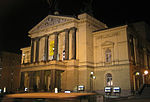Czech Radio
EngvarB from April 2014European Broadcasting Union membersMass media companies established in 1923Publicly funded broadcastersRadio stations established in 1923 ... and 2 more
Radio stations in the Czech RepublicState media
Český rozhlas (ČRo) is the public radio broadcaster of the Czech Republic, operating since 1923. The service broadcasts throughout the Czech Republic nationally and locally. Its four national services are Radiožurnál, Dvojka, Vltava and Plus. It is the oldest radio broadcaster in continental Europe and the second oldest in Europe after the BBC from the United Kingdom.
Excerpt from the Wikipedia article Czech Radio (License: CC BY-SA 3.0, Authors).Czech Radio
Vinohradská, Prague Vinohrady
Geographical coordinates (GPS) Address External links Nearby Places Show on map
Geographical coordinates (GPS)
| Latitude | Longitude |
|---|---|
| N 50.078611111111 ° | E 14.434444444444 ° |
Address
Český rozhlas
Vinohradská
120 00 Prague, Vinohrady
Prague, Czechia
Open on Google Maps










